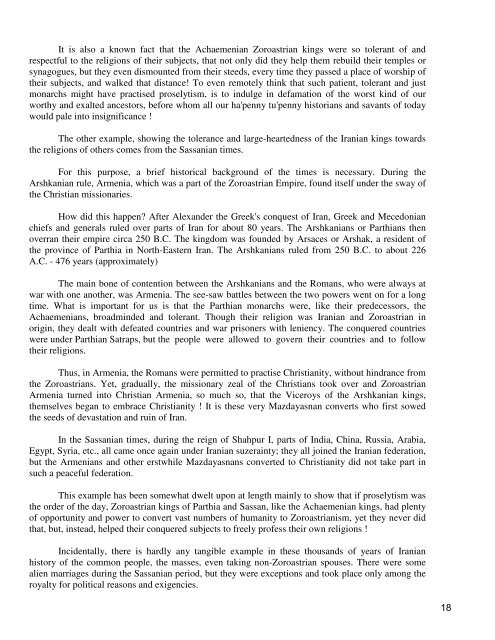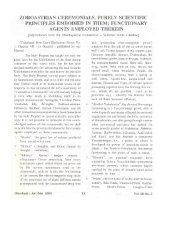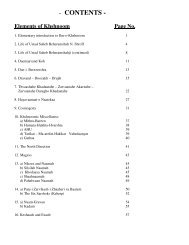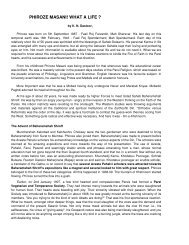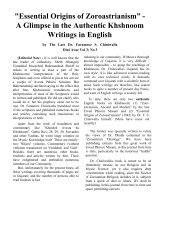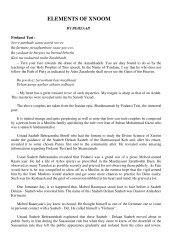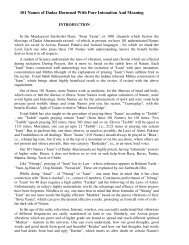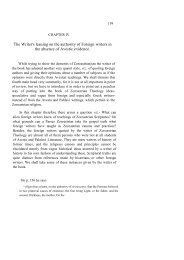Acceptance – Never Ever. - Traditional Zoroastrianism: Tenets of the ...
Acceptance – Never Ever. - Traditional Zoroastrianism: Tenets of the ...
Acceptance – Never Ever. - Traditional Zoroastrianism: Tenets of the ...
You also want an ePaper? Increase the reach of your titles
YUMPU automatically turns print PDFs into web optimized ePapers that Google loves.
It is also a known fact that <strong>the</strong> Achaemenian Zoroastrian kings were so tolerant <strong>of</strong> and<br />
respectful to <strong>the</strong> religions <strong>of</strong> <strong>the</strong>ir subjects, that not only did <strong>the</strong>y help <strong>the</strong>m rebuild <strong>the</strong>ir temples or<br />
synagogues, but <strong>the</strong>y even dismounted from <strong>the</strong>ir steeds, every time <strong>the</strong>y passed a place <strong>of</strong> worship <strong>of</strong><br />
<strong>the</strong>ir subjects, and walked that distance! To even remotely think that such patient, tolerant and just<br />
monarchs might have practised proselytism, is to indulge in defamation <strong>of</strong> <strong>the</strong> worst kind <strong>of</strong> our<br />
worthy and exalted ancestors, before whom all our ha'penny tu'penny historians and savants <strong>of</strong> today<br />
would pale into insignificance !<br />
The o<strong>the</strong>r example, showing <strong>the</strong> tolerance and large-heartedness <strong>of</strong> <strong>the</strong> Iranian kings towards<br />
<strong>the</strong> religions <strong>of</strong> o<strong>the</strong>rs comes from <strong>the</strong> Sassanian times.<br />
For this purpose, a brief historical background <strong>of</strong> <strong>the</strong> times is necessary. During <strong>the</strong><br />
Arshkanian rule, Armenia, which was a part <strong>of</strong> <strong>the</strong> Zoroastrian Empire, found itself under <strong>the</strong> sway <strong>of</strong><br />
<strong>the</strong> Christian missionaries.<br />
How did this happen? After Alexander <strong>the</strong> Greek's conquest <strong>of</strong> Iran, Greek and Mecedonian<br />
chiefs and generals ruled over parts <strong>of</strong> Iran for about 80 years. The Arshkanians or Parthians <strong>the</strong>n<br />
overran <strong>the</strong>ir empire circa 250 B.C. The kingdom was founded by Arsaces or Arshak, a resident <strong>of</strong><br />
<strong>the</strong> province <strong>of</strong> Parthia in North-Eastern Iran. The Arshkanians ruled from 250 B.C. to about 226<br />
A.C. - 476 years (approximately)<br />
The main bone <strong>of</strong> contention between <strong>the</strong> Arshkanians and <strong>the</strong> Romans, who were always at<br />
war with one ano<strong>the</strong>r, was Armenia. The see-saw battles between <strong>the</strong> two powers went on for a long<br />
time. What is important for us is that <strong>the</strong> Parthian monarchs were, like <strong>the</strong>ir predecessors, <strong>the</strong><br />
Achaemenians, broadminded and tolerant. Though <strong>the</strong>ir religion was Iranian and Zoroastrian in<br />
origin, <strong>the</strong>y dealt with defeated countries and war prisoners with leniency. The conquered countries<br />
were under Parthian Satraps, but <strong>the</strong> people were allowed to govern <strong>the</strong>ir countries and to follow<br />
<strong>the</strong>ir religions.<br />
Thus, in Armenia, <strong>the</strong> Romans were permitted to practise Christianity, without hindrance from<br />
<strong>the</strong> Zoroastrians. Yet, gradually, <strong>the</strong> missionary zeal <strong>of</strong> <strong>the</strong> Christians took over and Zoroastrian<br />
Armenia turned into Christian Armenia, so much so, that <strong>the</strong> Viceroys <strong>of</strong> <strong>the</strong> Arshkanian kings,<br />
<strong>the</strong>mselves began to embrace Christianity ! It is <strong>the</strong>se very Mazdayasnan converts who first sowed<br />
<strong>the</strong> seeds <strong>of</strong> devastation and ruin <strong>of</strong> Iran.<br />
In <strong>the</strong> Sassanian times, during <strong>the</strong> reign <strong>of</strong> Shahpur I, parts <strong>of</strong> India, China, Russia, Arabia,<br />
Egypt, Syria, etc., all came once again under Iranian suzerainty; <strong>the</strong>y all joined <strong>the</strong> Iranian federation,<br />
but <strong>the</strong> Armenians and o<strong>the</strong>r erstwhile Mazdayasnans converted to Christianity did not take part in<br />
such a peaceful federation.<br />
This example has been somewhat dwelt upon at length mainly to show that if proselytism was<br />
<strong>the</strong> order <strong>of</strong> <strong>the</strong> day, Zoroastrian kings <strong>of</strong> Parthia and Sassan, like <strong>the</strong> Achaemenian kings, had plenty<br />
<strong>of</strong> opportunity and power to convert vast numbers <strong>of</strong> humanity to <strong>Zoroastrianism</strong>, yet <strong>the</strong>y never did<br />
that, but, instead, helped <strong>the</strong>ir conquered subjects to freely pr<strong>of</strong>ess <strong>the</strong>ir own religions !<br />
Incidentally, <strong>the</strong>re is hardly any tangible example in <strong>the</strong>se thousands <strong>of</strong> years <strong>of</strong> Iranian<br />
history <strong>of</strong> <strong>the</strong> common people, <strong>the</strong> masses, even taking non-Zoroastrian spouses. There were some<br />
alien marriages during <strong>the</strong> Sassanian period, but <strong>the</strong>y were exceptions and took place only among <strong>the</strong><br />
royalty for political reasons and exigencies.<br />
18


